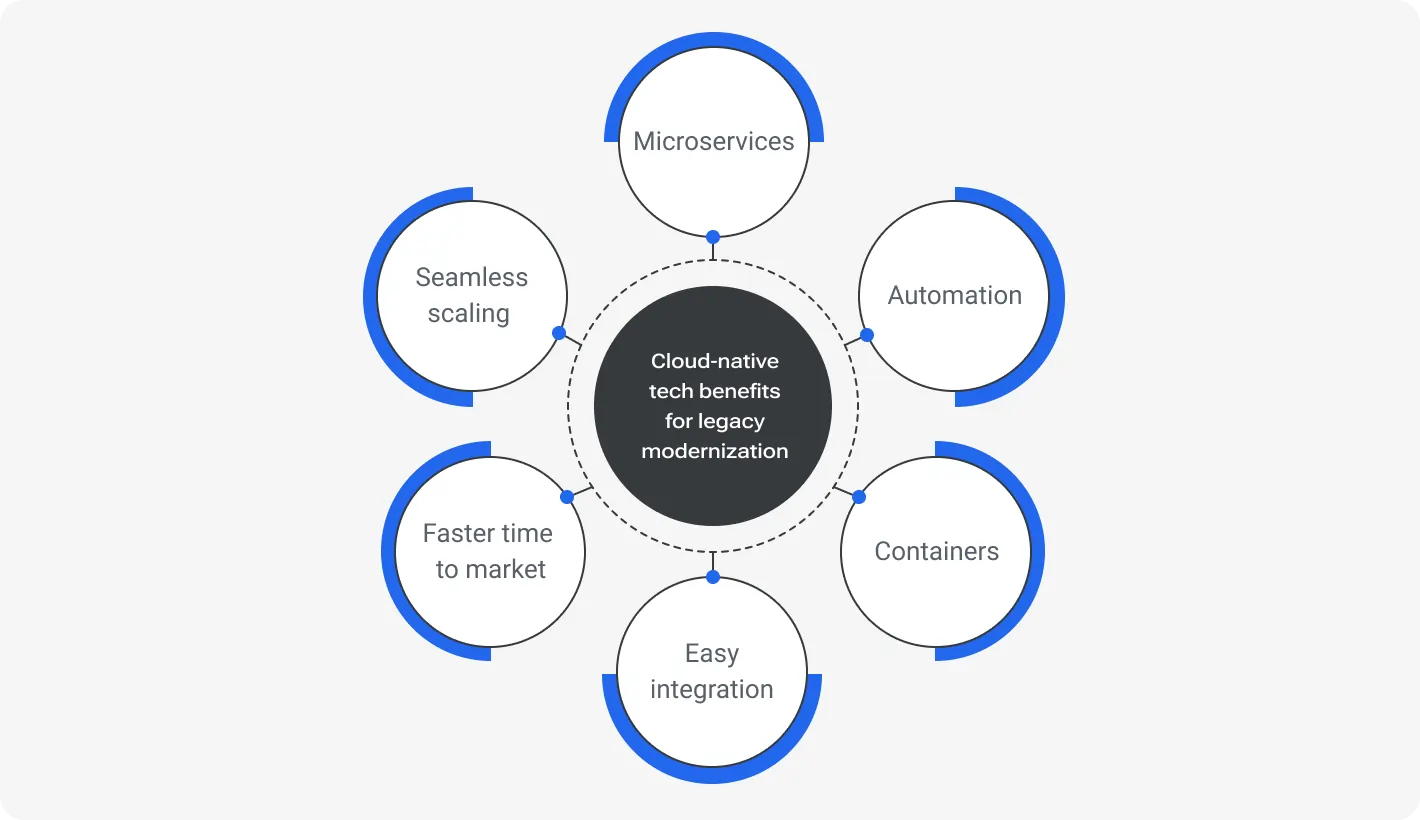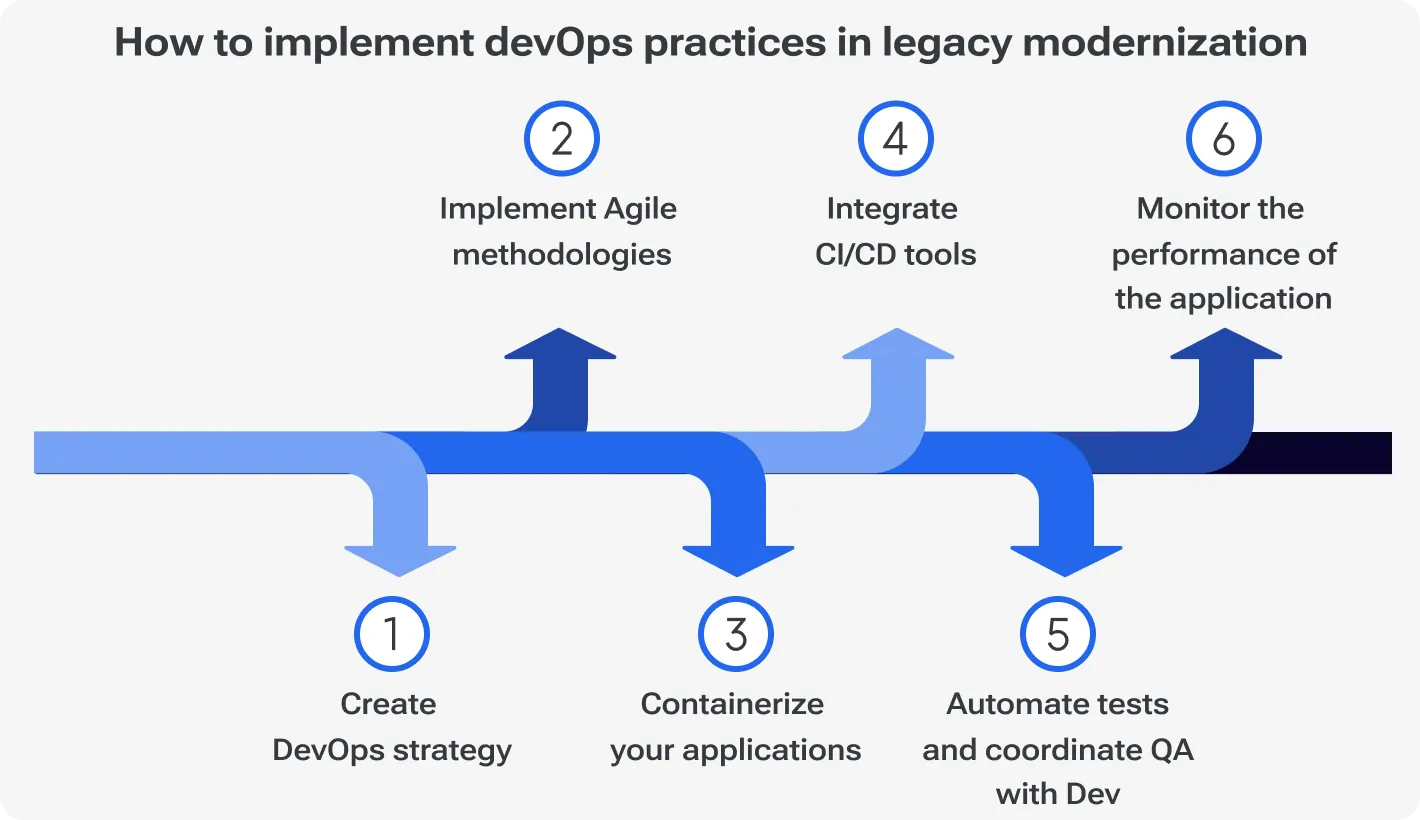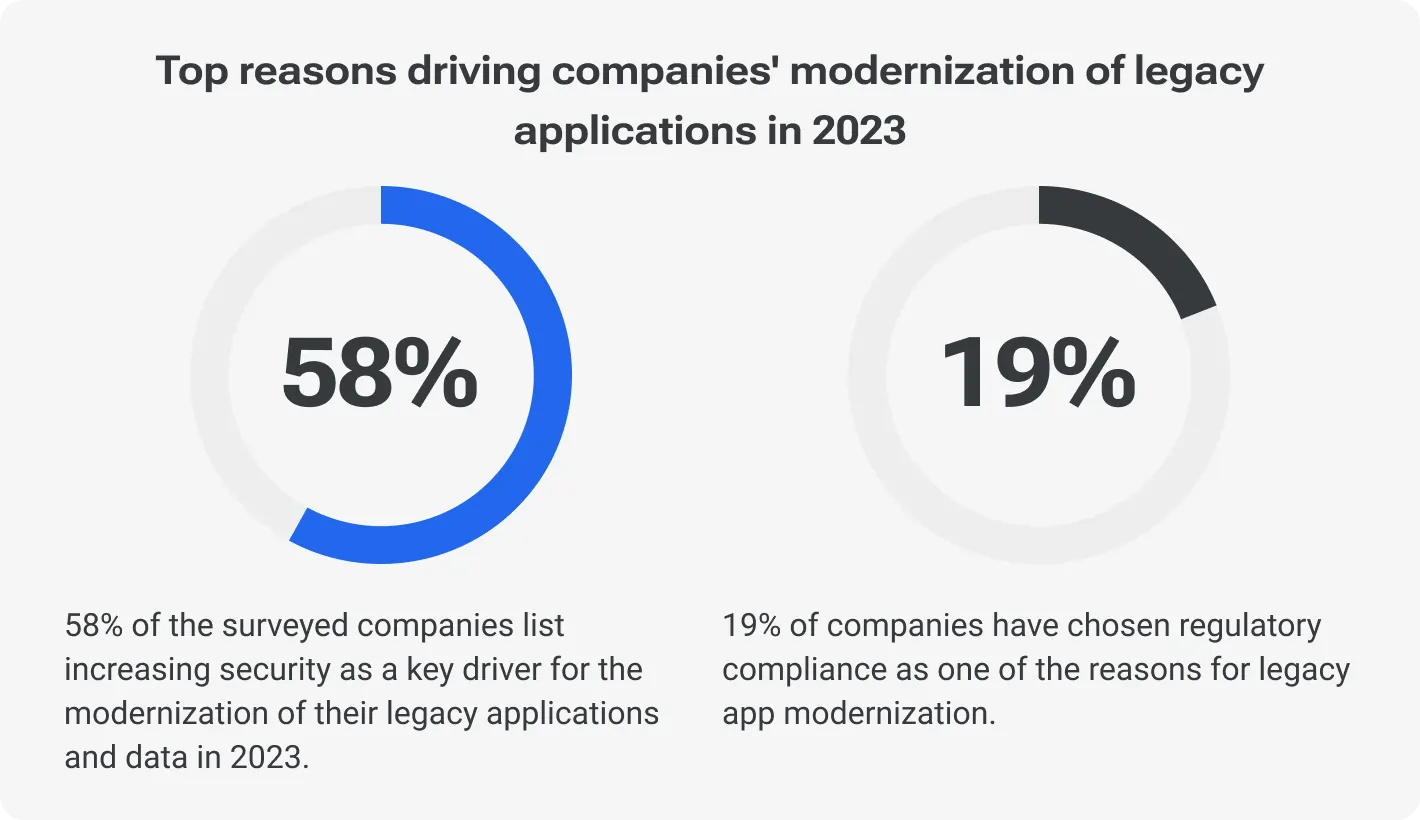Outsourcing to Czechia

How much does it cost to hire developers in Czechia?
Dec 2nd 25 - by Devico Team
Find out how much it costs to hire software developers in Czechia in 2025. Compare hourly rates, roles, and factors that impact pricing.
Hire
Hire by role
Hire Front-end developers
Hire Back-end developers
Hire Full-stack developers
Hire Android developers
Hire iOS developers
Hire Mobile developers
Hire AI engineers
Hire ML engineers
Hire Automation QA engineers
Hire Blockchain developers
Hire Data engineers
Hire Cloud engineers
Hire by skill
Hire JavaScript developers
Hire TypeScript developers
Hire Ruby on Rails developers
Hire React Native developers
Hire Flutter developers
Hire Golang developers
Hire React.js developers
Hire Python developers
Hire PHP developers
Hire .NET developers
Hire Java developers
Hire Laravel developers

Legacy modernization
May 16, 2024 - by Devico Team
Summarize with:
Modern business is a race; if you want to win it, you should stay ahead of your competitors as long as possible. The strategy is pretty simple: identify obstacles or pitfalls, work with them, and overcome them in the most efficient way. Often, the anchor that holds you back is legacy software. It is outdated, slow, non-scalable, and with too many other issues that impact the performance. So, how can you overcome all those challenges and get solid and capable applications?
From a long-term perspective, you have several options: rehost, refactor, re-platform, re-architecture, or fully replace the obsolete application. Let's be honest, the last one won't be your number-one choice, hence, you're up to legacy modernization.
Let’s take a closer look at the latest legacy modernization trends that might be helpful for you. Hope, you’ll find strategies that will boost your legacy modernization process.
This trend has been constantly emerging for the past few years, and most modern applications are already built with cloud-native technologies in mind. While legacy modernization with cloud-based tech is quite challenging, migration to the cloud is extremely beneficial. These platforms are revolutionizing application deployment by offering increased flexibility and efficiency. Organizations are moving to containerized environments, which enable agile development methods and smooth scaling.

However, it's not just migration to public, private, or in-house cloud environments, it is an opportunity to get a robust competitive advantage. Many cloud storage providers offer out-of-the-box solutions that can save time and budget and can be tailored to specific business needs: from easy third-party integration to the adoption of disruptive AI solutions.
The core downfall is hidden in the migration process. You might need the help of a professional team that ensures a smooth and seamless transition considering possible security and data loss issues. Here is how it can be successfully applied in practice.
Capital One, a top 10 financial services provider in the US, is stated to be the cloud-first organization in the industry. They started their journey long before cloud-based tech became mainstream and proceeded to enhance it till now.
Chris Nims, senior vice president of cloud and productivity engineering at Capital One, stated: “Going all in on the cloud has enabled both instant provisioning of infrastructure and rapid innovation. We are able to manage data at a much larger scale and unlock the power of machine learning to deliver enhanced customer experiences.”
It is all about automation, in-depth analysis, smart advising, and decision-making. AI tools and algorithms are widely used for legacy modernization: from code review to advising on creating new user interfaces. Combined with ML, it helps to identify and pinpoint weaknesses in the outdated application. Moreover, it offers best practices to renovate and improve services. It is one of the most popular legacy modernization trends & strategies due to its advantages:
Adaptable data analysis
Smart automation
Migration assistance
Cost-efficiency
Increased agility
Unfortunately, what makes artificial intelligence and machine learning such useful and appealing tools is also its drawback. Compared to involving a whole bunch of engineers and other specialists for legacy modernization, AI tools could be much more cost-efficient, however, if your project requires a lot of effort your budget can be expanded significantly. Regulatory and compliance can also become an issue, especially in spheres with law-provided limits and restrictions. Read more about AI's impact on legacy modernization, best practices, and pitfalls to avoid here. Now let's take a look at the practical example.
American Airlines has launched Smart Gating, a system based on artificial intelligence and machine learning to optimize operations and reduce taxiing times. The system has been deployed in major American Airlines hubs and allows for saving aviation fuel, decreasing carbon emissions, and improving operational efficiency.
The Smart Gating implementation has shortened the time spent on the taxiway by up to 20%. The system uses a combination of real-time flight information and other operational data to ensure aircraft are assigned the nearest exits, limiting the need to taxi through the terminal and reducing exit conflicts by 50%.
Anne Moroni, Vice President of Operations Planning and Performance, said: “We’re always looking for ways to drive operational improvement. We make gating decisions thousands of times a day. Saving precious time on the ground ensures more customers make their connections and we use our resources efficiently.”
DevOps is also among recent application modernization trends. Simply put, the DevOps approach brings software development and operations together, rather than using them separately.
DevOps implementation leads to change in organizational culture to accelerate the delivery of higher-quality software by automating and integrating the efforts of development teams and IT operations. With DevOps practices, companies become more agile and proactive. They get a view of how their software systems behave in real-world scenarios as they continuously deploy software updates and new features to meet user needs. According to MarketSplash, 49% of organizations reported faster time to market and better frequency of deployment thanks to DevOps.
As it still might sound quite extraordinary we've developed a small step-by-step guide for you on how to implement DevOps practices in the legacy software modernization process.

Your team must be united with one common goal but separated by personal duties. While close collaboration is essential, everyone should understand their role in the result and do their best as it impacts everyone due to continuous deployment.
Methodologies such as Scrum or Kanban allow you to monitor the project almost in real-time and quickly respond to needs: provide information, solve challenges, etc.
Application containerization makes your applications runnable and lightweight. Container packaging increases the reliability of the software during operations. In addition, the container parts of the application make it independent of the general infrastructure.
Containerization requires active management. Infrastructure automation tools combined with CI/CD tools can solve the challenges of effective configuration management and deployment.
Automating more tests will create faster delivery cycles, improve quality, and increase test coverage. However, don't try to automate everything at once. QA-Dev coordination enables early detection of bugs and helps developers resolve issues before the next release.
Modernization does not end with the launch of new options or new updates, monitoring the performance of the program is necessary to notice bugs and possible failures of the program in time.
DevOps and Agile methodology implementation allows you to significantly reduce time to market, as well as, new features development since the time for testing is reduced by automation, and short scrums allow you to identify and fix bugs shortly, leveling up the quality of the app.
Security might be one of the crucial weak points of outdated software as it creates an opportunity for fraudsters and hackers to get access to the company's vulnerable information. It is one of the concerns of the Financial and Healthcare sectors, as they collect and store the personal information of their clients and patients. As any personal data might be used for malicious purposes they should be aware of the latest security and compliance modernization strategies. Here are some legacy modernization techniques that’ll help you to protect sensitive data.

1. In-built safety protocols. Transforming a legacy application, embed security protocols into its core using the latest technology to protect your data from leaks and breaches. Implement additional measures, like double authentication, to make sure only authorized users have access to the data. Educate your clients and employees on security measures and techniques.
2. Encryption. In simple words, encryption is encoding your information and providing access to it only with a special key. Make sure you use the latest encryption protocols or tools such as OpenSSL to have the highest level of protection. Blockchain as well is a good way to encrypt and keep the info safe.
3. Ongoing security adherence. Installing and using modern technologies may not be enough to ensure the safety of your data. You must constantly monitor and update security protocols so that they can withstand the latest viruses and methods of breaking into the system. Automate monitoring with AI-based tools or apply something reliable, like Falco.
Moreover, you should also focus on compliance modernization. Ensure that data protection regulations such as GDPR (General Data Protection Regulation) are followed during the legacy software modernization. In addition, it is necessary to comply with industry requirements and standards to avoid possible further problems with regulatory organizations.
The talent gap might be not one of the obvious legacy modernization trends but the one that should be considered.
The application modernization services market is forecast to reach $32.8 billion by 2027 compared with $15.2 billion in 2022, with a CAGR of 16.7 percent.
Manpower Group survey states that 75% of employers worldwide report difficulty in filling roles.
This rapid growth creates a growing demand for technical specialists who understand the legacy modernization process and are keen on application modernization trends. Here is a hidden catch. The constant and very fast development of technologies implies that specialists will also keep abreast and have enough knowledge and experience to use them. IT engineers for legacy modernization should be experts in the field to lead your company to success and achieving business goals. Even more insidiously, your specialist must know not only the latest technologies but also the outdated ones to be able to replace them and not destroy the application. Yet, you have two options in this situation:
One is to grow your own in-house IT department and specialists who will know your system from up to down. It might be a costly investment and take much more time. However, if we talk about the long-term perspective, this method can be more profitable because you get not only a highly qualified specialist but also a loyal worker, who will leverage his best qualities and skills to help you go through any challenges. It is also a good way to overcome a continuous talent shortage and make a good contribution to your future.
The other way is to find reliable IT partners, access their talent pool, select a perfect team for your purposes, and get an instant competitive advantage; while others will build strategies, you'll already implement them. However, you have to be very careful and precise in choosing the partner for this job: study the portfolio, research the testimonials of previous clients, if possible talk to them in person, conduct several interviews with potential team members, and make sure you are on the same page and they understand your needs and meet your requirements.
Legacy modernization is an ongoing process that requires smart and agile approaches. Sometimes literally. The latest application modernization trends offer several options. You might choose one of them or a perfectly fitted combination but don’t forget to consult specialists to adopt best practices not mistakes. Thus, which of the following is an example of legacy modernization you'd like to implement?
Cloud-native technologies are still on the top of the list as they offer s lot of opportunities for further growth and scale: accessible maintenance, easy integration with the newest programs and updates, and out-of-the-box solutions from robust vendors. AI and ML are breathing on their backs as they have great potential for automation, in-depth analysis, and smart improvements for almost any essential app component. Agile methodologies are widely used in the development process now, combine it with DevOps and you’ll get an almost state-of-art result: a speed-up development process, higher-quality application, and ongoing maintenance. Don’t forget to invest actively in security and compliance improvements: it is crucial to keep your data safe using the latest options (protocols, tools, encryption, etc). Last but not least, look for foolproof specialists to apply modern legacy modernization software: while technology is developing, your engineers should also fit in.
The use of outdated software leads to many negative consequences, from slow app operation to gaps in security. In order to avoid possible problems, it is crucial to use modern technologies and update software promptly. You have to meet customer expectations to stay ahead of your competitors, sometimes it means completely renovating and modernizing the app by implementing disruptive technologies to boost productivity and increase performance.
If you want to win the race and overtake all your competitors in the future, choose ways that will allow you to start accelerating today.
Outsourcing to Czechia

Dec 2nd 25 - by Devico Team
Find out how much it costs to hire software developers in Czechia in 2025. Compare hourly rates, roles, and factors that impact pricing.
Outsourcing to Czechia

Nov 25th 25 - by Devico Team
Compare Czechia and Poland for software outsourcing in 2025. Discover costs, talent, infrastructure, and which country fits your project best.
Outsourcing to Czechia

Nov 18th 25 - by Devico Team
A complete guide to outsourcing software projects to Czechia, learn about costs, talent, benefits, and how to build successful partnerships in 2025.